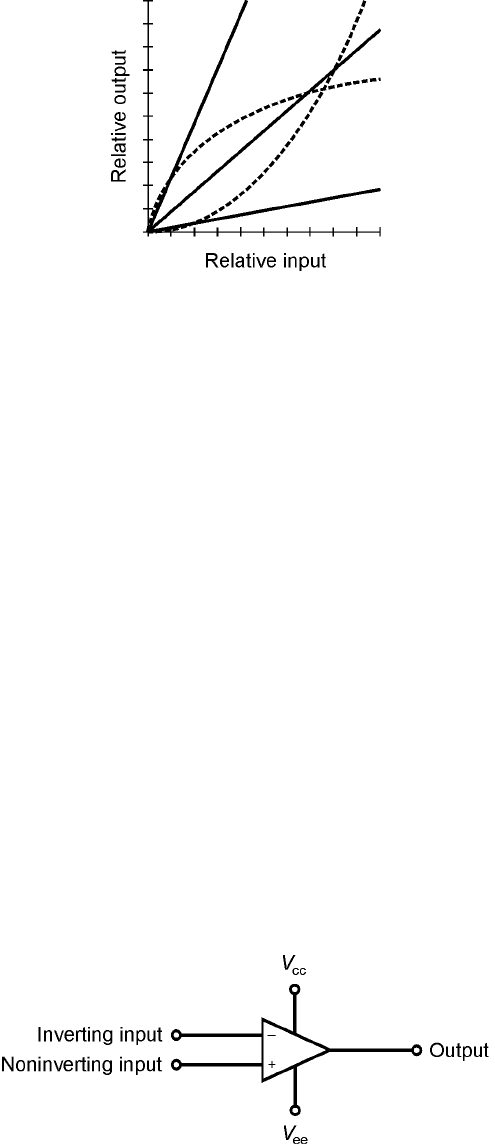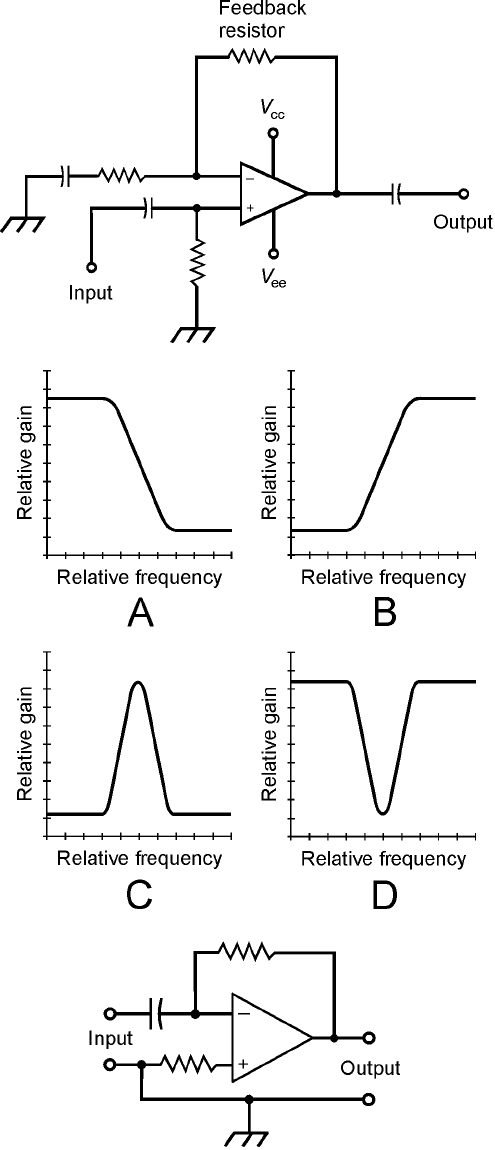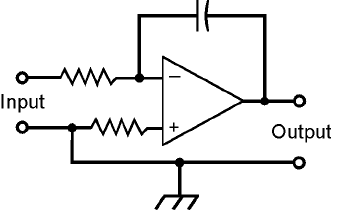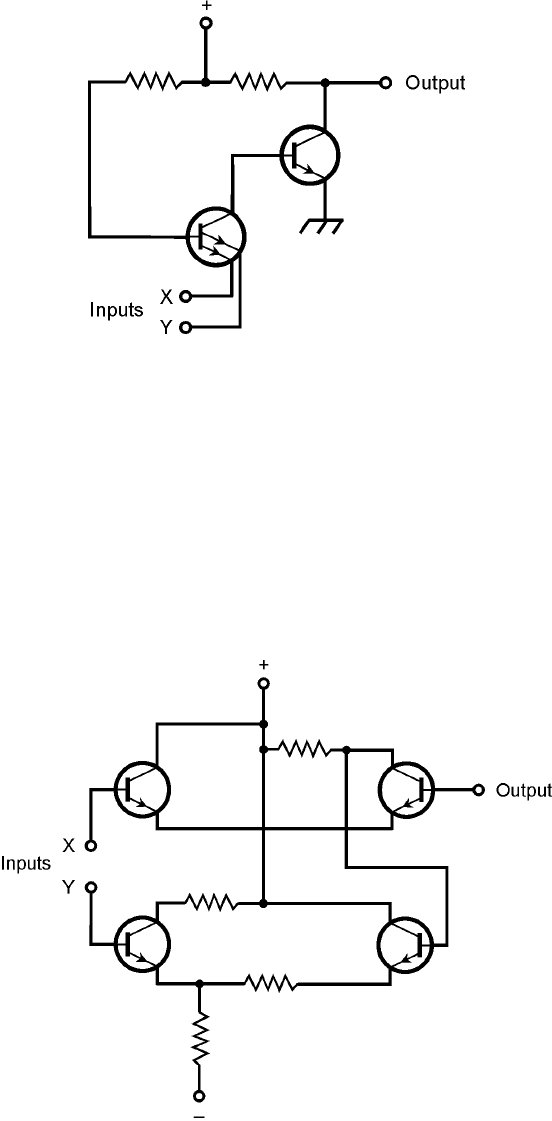Gibilisco S. Teach Yourself Electricity and Electronics
Подождите немного. Документ загружается.

INTEGRATED CIRCUITS (ICs), ALSO CALLED CHIPS, HAVE STIMULATED AS MUCH EVOLUTION AS ANY
single development in the history of electronic technology. Most ICs look like gray or black plastic
boxes with protruding pins. The schematic symbols are triangles or rectangles with lines emerging
from them, labeled according to their functions.
Advantages of IC Technology
Integrated circuits have advantages over discrete components (individual transistors, diodes, capaci-
tors, and resistors). Here are some of the most important considerations.
Compactness
An obvious asset of IC design is economy of space. They are far more compact than equivalent cir-
cuits made from discrete components. A corollary to this is the fact that more complex circuits can
be built, and kept down to a reasonable size, using ICs as compared with discrete components.
High Speed
The interconnections among the components within an IC are physically tiny, making high switch-
ing speeds possible. Electric currents travel fast, but not instantaneously. The less time charge carri-
ers need to get from component X to component Y, in general, the more computations are possible
within a given span of time, and the less time is needed for complex operations.
Low Power Consumption
Another advantage of ICs is the fact that they use less power than equivalent discrete-component
circuits. This is crucial if batteries are to be used for operation. Because ICs use so little current, they
produce less heat than their discrete-component equivalents. This translates into better efficiency. It
also minimizes the problems that bedevil equipment that gets hot with use, such as frequency drift
and generation of internal noise.
491
28
CHAPTER
Integrated Circuits
Copyright © 2006, 2002, 1997, 1993 by The McGraw-Hill Companies, Inc. Click here for terms of use.
Reliability
Integrated circuits fail less often, per component-hour of use, than systems that use discrete compo-
nents. This is because all the component interconnections are sealed within the IC case, preventing
corrosion or the intrusion of dust. The reduced failure rate translates into less downtime, or time
during which the equipment is out of service for repairs.
Ease of Maintenance
Integrated-circuit technology lowers maintenance costs. Repair procedures are simplified when fail-
ures occur. Many appliances use sockets for ICs, and replacement is simply a matter of finding the
faulty IC, unplugging it, and plugging in a new one. Special desoldering equipment is used with ap-
pliances having ICs soldered directly to the circuit boards.
Modular Construction
Modern IC appliances use modular construction. In this scheme, individual ICs perform defined
functions within a circuit board; the circuit board or card, in turn, fits into a socket and has a spe-
cific purpose. Computers, programmed with customized software, are used by repair technicians to
locate the faulty card in an appliance. The whole card can be pulled and replaced, getting the appli-
ance back to the consumer in the shortest possible time. Then a computer can be used to trou-
bleshoot the faulty card, getting the card ready for use in the next appliance that happens to come
along with a failure in the same card.
Limitations of IC Technology
No technological advancement ever comes without a downside. Integrated circuits have some limi-
tations that must be considered when designing an electronic system.
Inductors Impractical
While some components are easy to fabricate onto chips, other components defy the IC manufac-
turing process. Inductances, except for extremely low values, are an example. Devices using ICs
must generally be designed to work with discrete inductors, external to the ICs themselves. How-
ever, resistance-capacitance (RC) circuits are capable of doing most things that inductance-
capacitance (LC) circuits can do, and these can exist inside an IC.
High Power Impossible
The small size and low current consumption of ICs comes with an inherent limitation: high-power
amplifiers cannot, in general, be fabricated onto chips. High power necessitates a certain amount of
physical mass and volume. High-power devices and systems invariably generate large amounts of
heat, which must be efficiently radiated or conducted away.
Linear ICs
A linear IC is used to process analog signals such as voices, music, and radio transmissions.
The term linear arises from the fact that, in general, the amplification factor is constant as the
input amplitude varies. That is, the output signal strength is a linear function of the input signal
strength (Fig. 28-1).
492 Integrated Circuits

Operational Amplifier
An operational amplifier, or op amp, is a specialized linear IC that consists of several bipolar transis-
tors, resistors, diodes, and capacitors, interconnected so that high gain is possible over a wide range
of frequencies. An op amp might comprise an entire IC. Or, an IC might consist of two or more op
amps. Thus, you’ll sometimes hear of dual op amps or quad op amps. Some ICs have op amps in ad-
dition to other circuits.
An op amp has two inputs, one noninverting and one inverting, and one output. When a signal
goes into the noninverting input, the output is in phase with the input; when a signal goes into the
inverting input, the output is 180° out of phase with the input. An op amp has two power supply
connections, one for the emitters of the transistors (V
ee
) and one for the collectors (V
cc
). The usual
schematic symbol for an op amp is a triangle. The inputs, output, and power-supply connections
are drawn as lines emerging from it (Fig. 28-2).
The gain of an op amp is determined by one or more external resistors. Normally, a resistor is
connected between the output and the inverting input. This is called the closed-loop configuration.
The feedback is negative (out of phase), causing the gain of the op amp to be less than it would be
if there were no feedback (the open-loop configuration). Figure 28-3 is a schematic diagram of a non-
inverting closed-loop amplifier.
The reason for providing negative feedback in an op amp circuit is the fact that without it, the
gain may be too great. Excessive amplifier gain can cause problems. Open-loop op amps are prone
to instability, especially at low frequencies. They also generate a lot of internal noise.
When an RC combination is used in the feedback loop of an op amp, the gain depends on the
input-signal frequency. It is possible to get a lowpass response, a highpass response, a resonant peak, or
a resonant notch using an op amp and various RC feedback arrangements. These four types of re-
sponses are shown in Fig. 28-4.
Linear ICs 493
28-1 In a linear IC, the
relative output is a
linear (straight-line)
function of the relative
input. The solid lines
show examples of linear
IC characteristics. The
dashed curves show
functions not char-
acteristic of properly
operating linear ICs.
28-2 Schematic symbol
for an op amp.
Connections are
discussed in the text.

494 Integrated Circuits
28-4 Gain-versus-frequency
response curves.
At A, lowpass; at B,
highpass; at C,
resonant peak; at D,
resonant notch.
28-5 A differentiator circuit
that uses an op amp.
28-3 A closed-loop op amp
circuit with negative
feedback. If the
feedback resistor is
removed, it becomes
an open-loop circuit.

Op Amp Differentiator
A differentiator is an electronic circuit whose instantaneous output amplitude is proportional to the
rate at which the input amplitude changes. The circuit mathematically differentiates the input sig-
nal. Op amps can be used as differentiator circuits. An example is shown in Fig. 28-5.
When the input to a differentiator is a constant dc voltage, the output is zero (no signal). When
the input amplitude is increasing, the output is a positive dc voltage. When the input decreases, the
output is a negative dc voltage. If the input waveform fluctuates periodically (the usual case), the
output varies according to the instantaneous rate of change of the input amplitude. This results in
an output signal with the same frequency as that of the input signal, although the waveform is often
quite different. A pure sine wave input produces a pure sine wave at the output, but the phase is
shifted 90° to the left (that is,
1
⁄4 cycle earlier in time). Complex input waveforms can produce a
wide variety of outputs from a differentiator.
Op Amp Integrator
An integrator is an electronic circuit whose instantaneous output amplitude is proportional to the
accumulated input signal amplitude as a function of time. The circuit mathematically integrates
the input signal. The function of an integrator is basically the inverse, or opposite, of the func-
tion of a differentiator circuit. Figure 28-6 shows how an op amp can be connected to obtain an
integrator.
If an integrator circuit is supplied with an input signal waveform that fluctuates periodically
(the usual case), the output voltage varies according to the integral, or antiderivative, of the input
voltage. This results in an output signal with the same frequency as that of the input signal, although
the waveform is likely to be different. A pure sine wave input produces a pure sine wave output, but
the phase is shifted 90° to the right (that is,
1
⁄4 cycle later in time). Complex input waveforms can
produce many types of output waveforms.
An indefinite rise, either negatively or positively, in output voltage cannot occur in a practical
integrator. If the mathematical integral (in pure theory) of an input function is an endlessly increas-
ing output function, the actual output voltage rises to a certain maximum, either positive or nega-
tive, and stays there. This maximum is less than or equal to the power supply or battery voltage.
Voltage Regulator
A voltage regulator IC acts to control the output voltage of a power supply. This is important with
precision electronic equipment. These ICs are available with various voltage and current ratings.
Typical voltage regulator ICs have three terminals, and because of this, they are sometimes mistaken
for power transistors.
Linear ICs 495
28-6 An integrator circuit
that uses an op amp.
Timer
A timer IC is a specialized oscillator that produces a delayed output. The delay is adjustable to suit
the needs of a particular device. The delay is generated by counting the number of oscillator pulses;
the length of the delay can be adjusted by means of external resistors and capacitors. Timers are
commonly used in circuits such as digital frequency counters, where a precise time interval or win-
dow must be provided.
Multiplexer
A multiplexer IC allows several different signals to be combined in a single channel by means of a
process called multiplexing. An analog multiplexer can also be used in reverse; then it works as a de-
multiplexer. Thus, you’ll sometimes hear or read about a multiplexer/demultiplexer IC.
Comparator
A comparator IC has two inputs. It compares the voltages at the two inputs, which are called A and
B. If the voltage at input A is significantly higher than the voltage at input B, the output is about +5
V. This is logic 1, or high. If the voltage at input A is lower than or equal to the voltage at input B,
the output voltage is about +2 V. This is designated as logic 0, or low.
Voltage comparators are available for a variety of applications. Some can switch between low
and high states at a rapid rate of speed, while others are slow. Some have low input impedance, and
others have high impedance. Some are intended for AF or low-frequency RF use; others are fabri-
cated for video or high-frequency RF applications. Voltage comparators can be used to actuate, or
trigger, other devices such as relays and electronic switching circuits.
Digital ICs
A digital IC, also sometimes called a digital-logic IC, operates using two discrete states: high (logic
1) and low (logic 0). Digital logic is discussed in Chap. 26. Digital ICs contain massive arrays of
logic gates that perform Boolean operations at high speed.
Transistor-Transistor Logic
In transistor-transistor logic (TTL), arrays of bipolar transistors, some with multiple emitters, oper-
ate on dc pulses. This technology has several variants, some of which date back to around 1970. A
basic TTL gate is illustrated in Fig. 28-7. This gate uses two NPN bipolar transistors, one of which
is a dual-emitter device. The transistors are always either completely cut off, or else completely satu-
rated. Because of this, TTL is relatively immune to external noise.
Emitter-Coupled Logic
Another bipolar-transistor logic form is known as emitter-coupled logic (ECL). In an ECL device, the
transistors are not operated at saturation, as they are with TTL. This increases the speed. But noise
pulses have a greater effect in ECL, because unsaturated transistors are sensitive to, and can actually
amplify, external signals and noise. The schematic of Fig. 28-8 shows a basic ECL gate using four
NPN bipolar transistors.
496 Integrated Circuits

Metal-Oxide-Semiconductor Logic
Digital ICs can also be constructed using metal-oxide-semiconductor (MOS) devices. N-channel
MOS (NMOS) logic, pronounced “EN-moss logic,” offers simplicity of design, along with high op-
erating speed. P-channel MOS logic, pronounced “PEA-moss logic,” is similar to NMOS logic, but
the speed is slower. An NMOS or PMOS digital IC is like a circuit that uses only N-channel MOS-
FETs, or only P-channel MOSFETs, respectively.
Complementary-metal-oxide-semiconductor (CMOS) logic, pronounced “SEA-moss logic,” em-
ploys both N-type and P-type silicon on a single chip. This is analogous to using both N-channel
Digital ICs 497
28-7 A transistor-transistor
logic (TTL) gate. In
this gate, two NPN
bipolar transistors are
used. Note that one
of the transistors has
two emitters.
28-8 An emitter-coupled
logic (ECL) gate using
four NPN bipolar
transistors.
and P-channel MOSFETs in a circuit. The advantages of CMOS technology include extremely low
current drain, high operating speed, and immunity to noise.
All forms of MOS logic ICs require care in handling to prevent destruction by electrostatic dis-
charges. The precautions are the same as those that are required when handling MOSFETs. All tech-
nical personnel who work with the devices should be grounded. This can be achieved by having
technicians wear metal wrist straps connected to a good electrical ground, and by ensuring that the
relative humidity in the lab is not allowed to get too low. When MOS ICs are stored, the pins
should be pushed into special conductive foam that is manufactured for that purpose.
Component Density
The number of elements per chip in an IC is called the component density. There has been a steady
increase in the number of components that can be fabricated on a single chip. There is an absolute
limit on component density, imposed by the atomic structure of the semiconductor material—
literally, the size of the atoms! Technology has begun to approach that barrier.
Small Scale
In small scale integration (SSI), there are fewer than 10 transistors on a chip. These types of ICs can
carry the largest currents, and can be useful in voltage regulation and other moderate-power appli-
cations.
Medium Scale
In medium scale integration (MSI), there are 10 to 100 transistors per chip. This allows for consider-
able miniaturization, but it is not a high level of component density, relatively speaking. An advan-
tage of MSI (in a few applications) is that fairly large currents can be carried by the individual gates.
Both bipolar and MOS technologies can be adapted to MSI.
Large Scale
In large scale integration (LSI), there are 100 to 1000 transistors per semiconductor chip. This is an
order of magnitude (a factor of 10 times) more dense than MSI. Electronic wristwatches, single-chip
calculators, and simple microcomputers are examples of devices using LSI ICs.
Very-Large-Scale Devices
Very-large-scale integration (VLSI) devices have from 1000 to 1,000,000 transistors per chip. This
can be up to three orders of magnitude more dense than LSI. Microcomputers and memory ICs are
made using VLSI.
Ultra-Large-Scale Devices
You might sometimes hear of ultra-large-scale integration (ULSI). Devices of this kind have more
than 1,000,000 transistors per chip. The principal uses for this technology are in the fields of high-
level computing, supercomputing, robotics, and artificial intelligence (AI).
498 Integrated Circuits
IC Memory
Binary digital data, in the form of high and low levels (logic ones and zeros), can be stored in mem-
ory ICs. These devices can take various physical forms.
Random Access
A random access memory (RAM) chip stores binary data in arrays. The data can be addressed (selected)
from anywhere in the matrix. Data is easily changed and stored back in RAM, in whole or in part.
A RAM chip is sometimes called a read/write memory.
An example of the use of RAM is a word-processing computer file that you are actively work-
ing on. This paragraph, this chapter, and in fact the whole text of this book was written in semicon-
ductor RAM in small sections before being incrementally stored on the computer hard drive, and
ultimately on external media.
There are two major categories of RAM: dynamic RAM (DRAM) and static RAM (SRAM). A
DRAM chip contains transistors and capacitors, and data is stored as charges on the capacitors. The
charge must be replenished frequently, or it will be lost through discharge. Replenishing is done au-
tomatically several hundred times per second. An SRAM chip uses a flip-flop to store the data. This
gets rid of the need for constant replenishing of charge, but the tradeoff is that SRAM ICs require
more elements than DRAM chips to store a given amount of data.
With any RAM chip, the data in it will vanish when power is removed, unless some provision is
made for memory backup. The most common means of memory backup is the use of a small cell or bat-
tery with a long shelf life. Modern IC memories need so little current to store their data that a backup
battery lasts as long in the circuit as it would on the shelf. Memory that disappears when power is re-
moved is called volatile memory. If memory is retained when power is removed, it is nonvolatile.
Read Only
By contrast to RAM chips, the data in a read-only memory (ROM) chip can be easily accessed, in
whole or in part, but not easily written over. A standard ROM chip is programmed at the factory.
This permanent programming is known as firmware. But there are also ROM chips that you can
program and reprogram yourself. The data contents of ROM chips are generally nonvolatile. That
means a power failure is no cause for concern.
An erasable programmable ROM (EPROM) chip is an IC whose memory is of the read-only
type, but that can be reprogrammed by a certain procedure. It is more difficult to rewrite data in an
EPROM than in a RAM; the usual process for erasure involves exposure to ultraviolet (UV). An
EPROM IC can be recognized by the presence of a transparent window with a removable cover,
through which the UV is focused to erase the data. The IC must be taken from the circuit in which
it is used, exposed to UV for several minutes, and then reprogrammed.
The data in some EPROM chips can be erased by electrical means. Such an IC is called an elec-
trically erasable programmable read-only memory (EEPROM) chip. These do not have to be removed
from the circuit for reprogramming.
Quiz
Refer to the text in this chapter if necessary. A good score is at least 18 correct. Answers are in the
back of the book.
Quiz 499
1. Because of the small size of ICs compared with equivalent circuits made from discrete
components,
(a) more heat is generated.
(b) higher power output is possible.
(c) higher switching speeds are attainable.
(d) fewer calculations need to be done per unit time.
2. Which of the following is not an advantage of ICs over discrete components?
(a) Higher component density
(b) Ease of maintenance
(c) Lower gain
(d) Lower current consumption
3. In which of the following devices would you never find an IC as the main component?
(a) The final amplifier in a large radio broadcast transmitter
(b) The microprocessor in a personal computer
(c) A battery-powered calculator
(d) A low-power audio amplifier
4. Which, if any, of the following component types is not practical for direct fabrication on a
chip?
(a) Resistors
(b) Capacitors
(c) Diodes
(d) All three of the above component types are practical for direct fabrication on a chip.
5. An op amp circuit usually employs negative feedback to
(a) maximize the gain.
(b) control the gain.
(c) allow oscillation over a wide band of frequencies.
(d) Forget it! Op amp circuits never have negative feedback.
6. Suppose a communications channel carries several signals at once. Which type of IC might be
used to single one of the signals out for reception?
(a) An op amp
(b) A timer
(c) A comparator
(d) A multiplexer/demultiplexer
7. Which type of IC is commonly used to determine whether two dc voltages are the same or
different?
(a) An op amp
(b) A timer
500 Integrated Circuits
